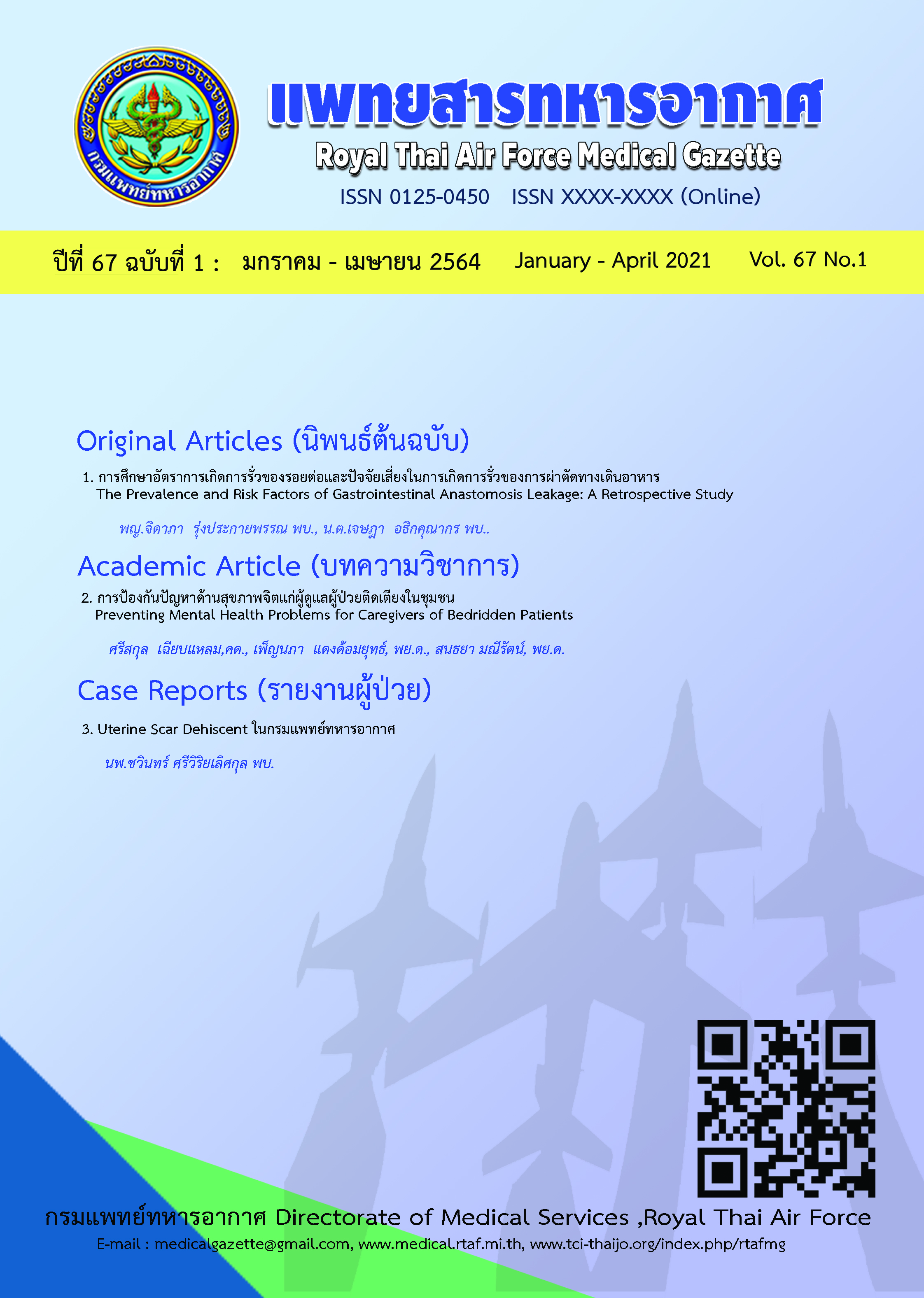Preventing Mental Health Problems for Caregivers of Bedridden Patients in the Community
Main Article Content
Abstract
The mental health of bedridden caregivers is extremely important. This is because bedridden caregivers are required to provide continuous, long-term care to patients throughout the day. These duties limit or take away their personal time or enough time to relax. The activities performed on the patient create a repetitive feeling and the boredom causes stress to accumulate and may create mental problems for the caregiver. From the study of Tha Chang Subdistrict Mueang Chanthaburi District, it was found that caregivers of bedridden patients can be divided into 3 types: caregivers who are relatives, caregiver that are neighbors, and caregivers who are employed to take care of patients at home. These three types of caregivers had no different stress level in caring for bedridden patients. This is due to insufficient knowledge and experience in caring for patients. According to the literature review, caregivers who had knowledge and experience. Therefore, to prevent mental health problems for caregivers of bedridden in the community health workers should be assessed and screened for mental health problems for their q1caregivers as well as providing knowledge and skills important in caring for bedridden patients
Article Details
บทความที่ได้รับการตีพิมพฺเป็นลิขสิทธิ์ของวารสาร
References
คณะกรรมการสุขภาพแห่งชาติ (สช.) และภาคีเครือข่าย. 2562.
2. ชนิกานต์ ส่วยนุ, ภูมิ ชมพูศรี, จิตรลดา อุทัยพิบูลย์. การศึกษาปัญหาสุขภาพด้านร่างกายและจิตใจ และความต้องการให้ช่วยเหลือของ
ผู้ดูแลผู้ป่วยติดเตียงในตำบลเวียงเหนือ อำเภอเชียงของ จังหวัดเชียงราย. วารสารสาธารณสุขและวิทยาศาสตร์สุขภาพ.
2561;2(2):62-9.
3. สายฝน เอกวรางกูร และปราณี เชษขุนทด. การพยาบาลจิตเวชและสุขภาพจิต :ศาสตร์และศิลป์สู่การปฏิบัติ 1.
มหาวิทยาลัยวลัยลักษณ์ นครศรีธรรมราช : โรงพิมพ์ไทม์ พริ้นติ้ง. 2558.
4. กุศลาภรณ์ ชัยอุดมสุข (บรรณาธิการ). จิตเวชศาสตร์. พิมพ์ครั้งที่ 2, ขอนแก่น : โรงพิมพ์คลังนานาวิทยา. 2560.
5. Siriphongam, Y. Caregiver at home: Concepts and problems in research. Ramathibodi Medical Journal.
1996;20(1):41-6.
6. วันดี สุทธรังสี, ถนอมศรี อินทนนท์ และศรีสุดา วนาลีสิน. การพยาบาลสุขภาพจิตแลจิตเวช (เล่ม 1). สงขลา: บริษัทนีโอพ้อยท์ (1995)
จำกัด. 2559.
7. Jeauuphattham, R. The needs of relatives who take care for stroke patients at home. Master of nursing Thesis in
Community Health Nursing Program. Graduate School, Christian University. 2010.
8. จินตนา วัชรสินธ์. การพยาบาลครอบครัวที่มีสมาชิกเจ็บป่วยเรื้อรัง. ชลบุรี : ชลบุรีการพิมพ์. 2560.
9. กัญญาณัฐ สุภาพร. ภาระในการดูแลและปัญหาสุขภาพจิตของผู้ดูแลผู้สูงอายุระยะประคับประคองที่บ้าน. วารสารเกื้อการุณย์.
2563;27(1):150-1.
10. ภัคจีรา ศุภวิชชา. คู่มือดูแลผู้ป่วยอัมพฤกษ์ อัมพาต. กรุงเทพมหานคร : บริษัทเคล็ดไทยจำกัด. 2557.
11. อัจฉรา พุ่มดวง. การพยาบาลพื้นฐาน: ปฏิบัติการพยาบาล. พิมพ์ครั้งที่ 5 , กรุงเทพมหานคร : สำนักพิมพ์
จุฬาลงกรณ์มหาวิทยาลัย. 2562.
12. สุปาณี เสนาดิสัย และวรรณภา ประไพพานิช. การพยาบาลพื้นฐาน. กรุงเทพมหานคร : บริษัท จุดทอง จำกัด. 2563.
13. อัมพรพรรณ ธีรานุตร, นงลักษณ์ เมธากาญจนศักดิ์ และดลวิวัฒน์ แสงโสม. คู่มือการดูแลผู้ป่วยโรคเรื้อรังที่บ้าน.ขอนแก่น :
โรงพิมพ์คลังนานาวิทยา. 2552.
14. สำนักการพยาบาล กระทรวงสาธารณสุข. การพยาบาลผู้ป่วยที่บ้าน. กรุงเทพฯ: โรงพิมพ์ ชุมนุมสหกรณ์การเกษตรแห่งประเทศไทย.
2556.


